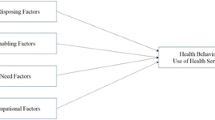Abstract
A community-university collaborative partnership assessed self-reported work-related health effects and environmental factors in Boston’s Vietnamese immigrant community via an interviewer-assisted survey. Seventy-one nail technicians responded. Musculoskeletal disorders, skin problems, respiratory irritation and headaches were commonly reported as work-related, as were poor air quality, dusts and offensive odors. The reporting of a work-related respiratory symptom was significantly associated with the reporting of exposure factors such as poorer air quality. Absence of skin disorders was associated with glove use and musculoskeletal symptoms were associated with years worked as a nail technician. Work-related health effects may be common in nail salon work. Chemical and musculoskeletal hazards should be reduced through product and equipment redesign.
Similar content being viewed by others
References
Federman MN, Harrington DE, Krynski KJ. Vietnamese manicurists: displacing natives or finding new nails to polish? Ind Labor Relat Rev 2006;59(2):302–18.
Nails Magazine Nails fact book 2004–2005. Torrance: Nails Magazine; 2004.
Cosmetic Industry Review Expert Panel Amended final report on the safety assessment of ethyl methacrylate. Int J Toxicol 2002;21(Supp 1):63–79.
Methacrylate Producers Association. The methacrylate producers association’s position on use of methacrylic acid and unreacted methacrylate monomers liquid form in cosmetic products; 2002 http://www.mpausa.org/mpapos.htm.
Hazardous Substances Data Bank. Methyl methacrylate; hazardous substances databank number:195: Bethesda: National Library of Medicine (US); 2005: http://toxnet.nlm.nih.gov/cgi-bin/sis/htmlgen?HSDB.
Marsee K, Woodruff TJ, Axelrad DA, Calafat AM, Swan SH. Estimated daily phthalate exposures in a population of mothers of male infants exhibiting reduced anogenital distance. Environ Health Perspect 2006;114(6):805–9.
John EM, Savitz DA, Shy CM. Spontaneous abortions among cosmetologists. Epidemiology 1994;5(2):147–55.
Hiipakka D, Samimi B. Exposure of acrylic fingernail sculptors to organic vapors and methacrylate dusts. Am Ind Hyg Assoc J 1987;48(3):230–7.
LoSasso GL, Rapport LJ, Axelrod BN. Neuropsychological symptoms associated with low-level exposure to solvents and (meth)acrylates among nail technicians. Neuropsychiatry Neuropsychol Behav Neurol 2001;14(3):183–9.
LoSasso GL, Rapport LJ, Axelrod BN, Whitman RD. Neurocognitive sequelae of exposure to organic solvents and (meth)acrylates among nail-studio technicians. Neuropsychiatry Neuropsychol Behav Neurol 2002;15(1):44–55.
Spencer AB, Estill CF, McCammon JB, Mickelsen RL, Johnston OE. Control of ethyl methacrylate exposures during the application of artificial fingernails. Am Ind Hyg Assoc J 1997;58(3):214–8.
Froines JR, Garabrant DH. Quantitative evalutaion of manicurists exposure to methyl, ethyl and isobutyl methacrylates during production of synthetic fingernails. Appl Ind Hyg 1986;1(2):70–4.
Belsito DV. Contact dermatitis to ethyl-cyanoacrylate-containing glue. Contact Dermatitis 1987;17(4):234–6.
Baran RL, Schibli H. Permanent paresthesia to sculptured nails. A distressing problem. Dermatol Clin 1990;8(1):139–41.
Freeman S, Lee MS, Gudmundsen K. Adverse contact reactions to sculptured acrylic nails: 4 case reports and a literature review. Contact Dermatitis 1995;33(6):381–5.
Guin JD, Baas K, Nelson-Adesokan P. Contact sensitization to cyanoacrylate adhesive as a cause of severe onychodystrophy. Int J Dermatol 1998;37(1):31–6.
Alanko K, Susitaiva P, Jolanki R, Kanerva L. Occupational skin diseases among dental nurses. Contact Dermatitis 2004;50:77–82.
Savonius B, Keskinen H, Tuppurainen M, Kanerva L. Occupational respiratory disease caused by acrylates. Clin Exp Allergy 1993;23(5):416–24.
Piirila P, Hodgson U, Estlander T, Keskinen H, Saalo A, Voutilainen R, Kanerva L. Occupational respiratory hypersensitivity in dental personnel. Int Arch Occup Environ Health 2002;75(4):209–16.
Piirila P, Kanerva L, Keskinen H, Estlander T, Hytonen M, Tuppurainen M, Nordman H. Occupational respiratory hypersensitivity caused by preparations containing acrylates in dental personnel. Clin Exp Allergy 1998;28(11):1404–11.
Environmental Working Group. Skin deep: a safety assessment of ingredients in personal care products; 2004 http://www.ewg.org/reports/skindeep.
California safe cosmetics act of 2005; 2005 http://www.leginfo.ca.gov/cgi-bin/waisgate?WAISdocID=53453324010+0+0+0&WAISaction=retrieve.
Susitaival P, Flyvholm MA, Meding B, Kanerva L, Lindberg M, Svensson A, Olafsson JH. Nordic occupational skin questionnaire (nosq-2002): A new tool for surveying occupational skin diseases and exposure. Contact Dermatitis 2003;49(2):70–6.
Lax MB, Grant WD, Manetti FA, Klein R. Recognizing occupational disease–taking an effective occupational history. Am Fam Physician 1998;58(4):935–44.
SAS Institute I SAS statistical software. Cary, NC; 2001.
Centers for Disease Control and Prevention (CDC). National health and nutrition examination survey data: Hyattsville: National Center for Health Statistics U.S. Department of Health and Human Services; 2004 http://www.cdc.gov/nchs/data/nhanes/nhanes_03_04/rdq_c.pdf.
McDonald C, Checkoway H. Methodology: 18 study design. In: McDonald C, editor. Epidemiology of work related diseases. London: BMJ Books; 2000. p. 385.
National Center for Chronic Disease Prevention and Health Promotion Centers for Disease Control and Prevention. Behavioral risk factor surveillance system online prevalence data: Atlanta, GA; 2003.
NIOSH. Hazard controls: Controlling chemical hazards during the application of artificial fingernails: Cincinnati: National Institute for Occupational Safety and Health; 1999.
OPI Products. Material safety data sheet: Nail lacquer. 1996.
Nail Systems International. Material safety data sheet: NSI universal nail liquid; 2002.
Feeney M. Ventilation—methods for investigating odor complaints related to nail salons: Bureau of Environmental Health Assessment, MA Dept. of Public Health; 2002 http://www.state.ma.us/dph/beha/iaq/nails/nails.htm.
Acknowledgments
Long Nguyen facilitated the development of the collaboration between Viet-AID and UMass Lowell. Thong Nguyen contributed many thoughtful suggestions regarding the design of questions and recruitment of participants. The interviewers recruited participants, conducted interviews, and shared valuable insights about the survey process. Michael Ellenbecker, Marlene Goldman, Laura Punnett, Donald Milton helped to design and critique questionnaire items. This study was funded by a Harvard NIOSH ERC Pilot Grant and by NIOSH Grants OH K01 OH007956-01 and K01 OH00178-03.
Author information
Authors and Affiliations
Corresponding author
Rights and permissions
About this article
Cite this article
Roelofs, C., Azaroff, L.S., Holcroft, C. et al. Results from a Community-based Occupational Health Survey of Vietnamese-American Nail Salon Workers. J Immigrant Minority Health 10, 353–361 (2008). https://doi.org/10.1007/s10903-007-9084-4
Published:
Issue Date:
DOI: https://doi.org/10.1007/s10903-007-9084-4




